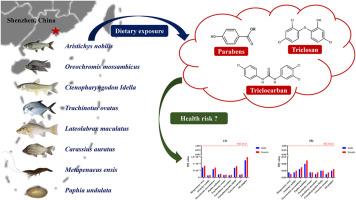中国深圳水产品中的对羟基苯甲酸酯、三氯生和三氯卡班及其相对健康风险。
IF 8.1
2区 环境科学与生态学
Q1 ENVIRONMENTAL SCIENCES
引用次数: 0
摘要
食用受污染的水产品可能会使人类接触到对羟基苯甲酸酯、三氯生(TCS)和三氯卡班(TCC)的残留物。尽管其意义重大,但有关这一问题的实证研究仍然有限。在这项研究中,我们采用高效液相色谱-串联质谱法(HPLC-MS/MS)分析了从广东省深圳市当地市场随机采集的 245 份水产品样品的提取物。我们的分析在 88 个样品(35.9%)中检测到至少一种对羟基苯甲酸酯--4-羟基苯甲酸甲酯(MeP)、4-羟基苯甲酸乙酯(EtP)、4-羟基苯甲酸丙酯(PrP)、4-羟基苯甲酸丁酯(BuP)和 4-羟基苯甲酸苄酯(BeP)。在 50.6% 和 51.4% 的样品中分别发现了对羟基苯甲酸三辛酯和对羟基苯甲酸三CC,其中 MeP 是最常检测到的对羟基苯甲酸酯。TCS 和 MeP 之间(r = -0.129,p < 0.05)以及 TCC 和 MeP 之间(r = -0.176,p < 0.05)呈显著负相关,表明这些污染物的潜在来源不同。不同类型水产品的残留水平各不相同,与甲壳类动物和双壳类动物相比,鱼类体内的三氯碳氢化合物和三氯苯甲醚浓度较高。研究发现,摄入这些污染物对男性和女性造成的健康风险都很小。这项研究为了解与接触对羟基苯甲酸酯、三氯碳氢化合物和三氯苯甲醚有关的膳食风险提供了宝贵的见解。本文章由计算机程序翻译,如有差异,请以英文原文为准。

Parabens, triclosan, and triclocarban in aquatic products from Shenzhen, China and the relative health risk
The consumption of contaminated aquatic products may expose humans to residues of parabens, triclosan (TCS), and triclocarban (TCC). Despite its significance, empirical research on this issue remains limited. In this study, we employed high-performance liquid chromatography-tandem mass spectrometry (HPLC-MS/MS) to analyze extracts from 245 aquatic product samples collected randomly from local markets in Shenzhen, Guangdong Province. Our analysis detected at least one of the five parabens—methyl 4-hydroxybenzoate (MeP), ethyl 4-hydroxybenzoate (EtP), propyl 4-hydroxybenzoate (PrP), butyl 4-hydroxybenzoate (BuP), and benzyl 4-hydroxybenzoate (BeP)—in 88 samples (35.9%). TCS and TCC were found in 50.6% and 51.4% of the samples, respectively, with MeP being the most frequently detected paraben. Significant negative correlations were observed between TCS and MeP (r = −0.129, p < 0.05) and between TCC and MeP (r = −0.176, p < 0.05), indicating potential different sources for these contaminants. Residue levels varied among different types of aquatic products, with TCS and TCC concentrations being higher in fish compared to crustaceans and bivalves. The health risk associated with consuming these contaminants was found to be minimal for both males and females. This study provides valuable insights into the dietary risks associated with exposure to parabens, TCS, and TCC.
求助全文
通过发布文献求助,成功后即可免费获取论文全文。
去求助
来源期刊

Chemosphere
环境科学-环境科学
CiteScore
15.80
自引率
8.00%
发文量
4975
审稿时长
3.4 months
期刊介绍:
Chemosphere, being an international multidisciplinary journal, is dedicated to publishing original communications and review articles on chemicals in the environment. The scope covers a wide range of topics, including the identification, quantification, behavior, fate, toxicology, treatment, and remediation of chemicals in the bio-, hydro-, litho-, and atmosphere, ensuring the broad dissemination of research in this field.
 求助内容:
求助内容: 应助结果提醒方式:
应助结果提醒方式:


